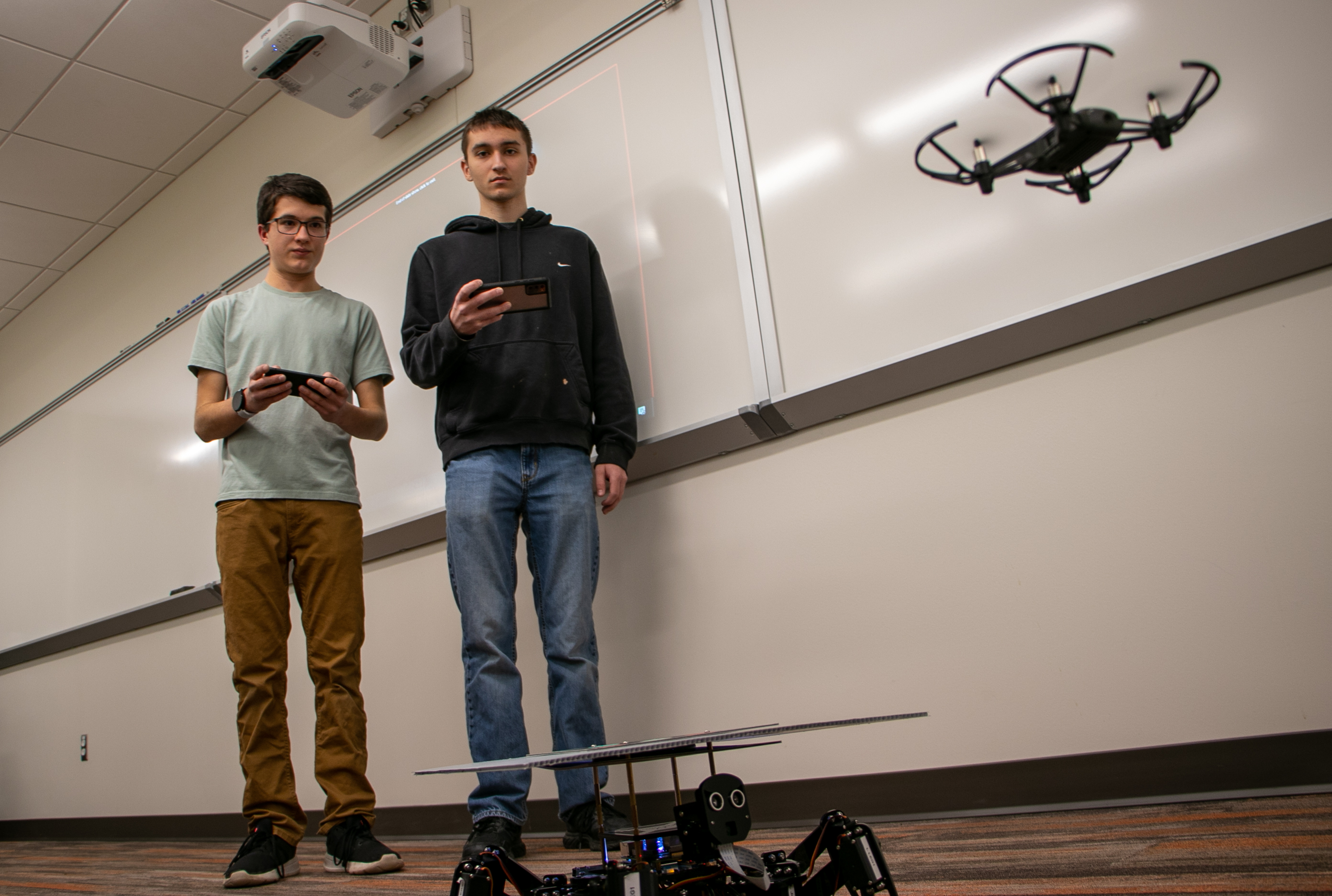Campus News
December 13th, 2022
GC students put engineering theory into practice
Drone project relied upon an iterative engineering design process

Photo by John Rudd
Garrett College students Ryan Busch, left, and Tyre Medlin land an Unmanned Aerial Vehicle (UAV) on a landing platform mounted to a hexapod robot as part of last Tuesday's Introduction to Engineering (ENR 100) class project.
Engineering is built on identifying problems and developing solutions. Garrett College students Ryan Busch and Tyre Medlin brought that process to life with a project developed for their Introduction to Engineering (ENR 100) class.
Busch and Medlin's project involved working through the engineering design process cycle to address the issue of low battery life in drones. The pair combined three subsystems – a hexapod robot, a specially designed landing pad, and an unmanned aerial vehicle (UAV) – to tackle the problem.
"We decided that a multi-terrain, mobile drone landing platform that supports automatic landing would work well to achieve our objectives," said Busch.
During the course of the project, they were able to construct and test the prototype, improve landing accuracy, and identify remaining challenges. The pair suggested software revisions to enhance landing precision and permit automatic charging, as well as physical modifications to allow the wireless charger signal to pass through the landing pad.
"This project is an example of how ambitious, hard-working students can create great things," Assistant Professor Paul Rached, who teaches the ENR 100 course, told a group of faculty, staff and administrators who attended last Tuesday's presentation.
The students assembled the hexapod robot and tested three sizes of landing pads and platforms. The landing pads and platforms were modified to include a wireless charger.
During testing, Busch and Medlin determined that moving from a small (7.5"-by-7.5") landing pad to larger landing platforms (up to 15"-by-15") significantly improved landing accuracy. The larger platform increased the chance the drone lands on its own successfully from 65 to at least 90 percent of the time.
"We used data to iterate the process," said Medlin, with the move to larger landing platforms being one of the improvements coming out of that data-driven, iterative process.
Evaluating the success and limitations of the first prototype led to suggested improvements. One significant identified challenge was the inability to have the drone land and charge automatically, leading to the suggested software revisions and physical modifications.
"The wireless charging receiver on the platform and the drone need to be perfectly aligned," said Busch, noting there was no successful landing directly on the center of the landing platform.
The presentation included two videos of the drone in action as well as a live drone demonstration that resulted in a successful landing on the platform mounted on the drone lander.
"The best learning environments encourage students to put theory into practice," noted Dr. Ryan Harrod, Garrett College's dean of academic affairs. "Ryan and Tyre's drone project was a great example of practical application of the engineering design process."
Notes: Busch and Medlin noted that their project was supported by the Daniel E. Offutt III Charitable Trust. They also reported some "fun facts," including that their drone had a maximum flight time of 13 minutes and that the Hexapod was capable of continuous operation for up to 20 minutes.
The students thanked Professor Rached, Garrett Engineering and Robotics Society (GEARS) founder Phil Malone, and engineer Ralph Busch (Ryan's father) for sharing their technical expertise. They also recognized fellow students Wood Clodfelter and Carder Stakem for their assistance.
"Teamwork created something amazing that we couldn't have imagined in the beginning," said Busch.
Medlin is a graduate of Northern Garrett High School and Busch is a home-schooled student attending GC as part of the High School Dual Enrollment Program.
Medlin credited his previous engineering education through Garrett County Public Schools with preparing him for the College's ENR 100 course.
"Without experience," said Medlin, "it's a lot harder to put engineering theory into practice."






